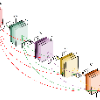We aim to optimize the binary detection of Chronic Obstructive Pulmonary Disease (COPD) based on emphysema presence in the lung with convolutional neural networks (CNN) by exploring manually adjusted versus automated window-setting optimization (WSO) on computed tomography (CT) images. 7,194 CT images (3,597 with COPD; 3,597 healthy controls) from 78 subjects (43 with COPD; 35 healthy controls) were selected retrospectively (10.2018-12.2019) and preprocessed. For each image, intensity values were manually clipped to the emphysema window setting and a baseline 'full-range' window setting. Class-balanced train, validation, and test sets contained 3,392, 1,114, and 2,688 images. The network backbone was optimized by comparing various CNN architectures. Furthermore, automated WSO was implemented by adding a customized layer to the model. The image-level area under the Receiver Operating Characteristics curve (AUC) [lower, upper limit 95% confidence] was utilized to compare model variations. Repeated inference (n=7) on the test set showed that the DenseNet was the most efficient backbone and achieved a mean AUC of 0.80 [0.76, 0.85] without WSO. Comparably, with input images manually adjusted to the emphysema window, the DenseNet model predicted COPD with a mean AUC of 0.86 [0.82, 0.89]. By adding a customized WSO layer to the DenseNet, an optimal window in the proximity of the emphysema window setting was learned automatically, and a mean AUC of 0.82 [0.78, 0.86] was achieved. Detection of COPD with DenseNet models was improved by WSO of CT data to the emphysema window setting range.
翻译:暂无翻译



